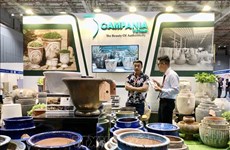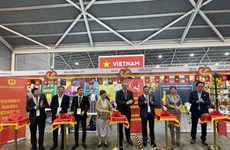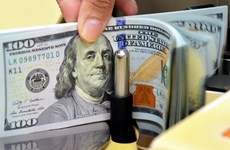Vietnam making great strides towards footwear supplier
Domestic and foreign-invested enterprises (FIEs) in the leather and
footwear sector continue to experience impressive growth, ranking
Vietnam the second largest global exporter of footwear, radio The Voice
of Vietnam (VOV) reported.
Domestic and foreign-invested enterprises (FIEs) in the leather and
footwear sector continue to experience impressive growth, ranking
Vietnam the second largest global exporter of footwear, radio The Voice
of Vietnam (VOV) reported.
In the first six months of the year, the nation’s footwear exports jumped 17.8 percent year-on-year to 4.8 billion USD, according to the Vietnam Leather and Footwear Association (Lefaso), and economists are now forecasting them to surpass the 11 billion USD benchmark by the end of the year.
The rebounding economies in the US and the EU are one of the key factors giving rise to the increased global demand. The footwear sector is experiencing but an equally important factor is the free trade pacts that are poised for signature.
The Trans-Pacific Partnership (TPP) Agreement and Vietnam-EU Free Trade Agreement (VEFTA) are likely to be signed later this year or early next year, and the optimism they are generating has touched off tremendous investment into the leather and footwear sector.
Numerous foreign invested projects are sprouting up throughout country installed with the latest state-of-the-art technologies, modernised and streamlined facilities that are contributing directly to raising the sectors added value in the production process.
Foreign material suppliers are pouring huge investment into the sector forging their niches in the Vietnamese market, and are aggressively seizing every opportunity to cooperate with Vietnamese partners.
With unanimity, they are reporting they consider 2014 as a pivotal year as they jockey to lay the foundation and get in position to benefit from the increased trading activities in the future once the TPP and VEFTA come into effect.
“Vietnam is the centre of focus by material suppliers at the 16th International Shoe and Leather Expo opened in Ho Chi Minh City on July 16,” Tran Vi Co, Director of Hien Dat Exhibition and Trading Services Company.
The number of foreign participants at the expo has increased by nearly 20 percent compared to last year and this year’s event has attracted a remarkable 150 businesses from 18 countries and territories, he added.
The opportunities are real, but whether domestic businesses will rise to the occasion and seize them remains an open question, he concludes.
Lefaso President Nguyen Duc Thuan emphasised that the increase in the use of domestic materials has been drawing much attention. The leather sector has usually used only 30 percent domestic materials.
In the future, this will increase significantly, Thuan said, adding the country is developing two leather industrial zones in two main regions. Furthermore, smaller IZs are in various stages of development in key regions to produce other materials, such as synthetic leather, shoes’ soles, and decorating materials.
The HCM City is going through a revolutionary transformation into a centre for supplying and exchanging materials for the whole sector.
The sector has set a target of using 100 percent of domestic tanned leather by 2020 and 50 percent of synthetic leather and 70 percent of shoes’ soles by 2050, Thuan said.
Currently, Lefaso devised measures to help the sector develop sustainably in the future. Training is one of its priorities. Accordingly, a human resource-training centre will be set up in the southern region in 2015.-VNA
In the first six months of the year, the nation’s footwear exports jumped 17.8 percent year-on-year to 4.8 billion USD, according to the Vietnam Leather and Footwear Association (Lefaso), and economists are now forecasting them to surpass the 11 billion USD benchmark by the end of the year.
The rebounding economies in the US and the EU are one of the key factors giving rise to the increased global demand. The footwear sector is experiencing but an equally important factor is the free trade pacts that are poised for signature.
The Trans-Pacific Partnership (TPP) Agreement and Vietnam-EU Free Trade Agreement (VEFTA) are likely to be signed later this year or early next year, and the optimism they are generating has touched off tremendous investment into the leather and footwear sector.
Numerous foreign invested projects are sprouting up throughout country installed with the latest state-of-the-art technologies, modernised and streamlined facilities that are contributing directly to raising the sectors added value in the production process.
Foreign material suppliers are pouring huge investment into the sector forging their niches in the Vietnamese market, and are aggressively seizing every opportunity to cooperate with Vietnamese partners.
With unanimity, they are reporting they consider 2014 as a pivotal year as they jockey to lay the foundation and get in position to benefit from the increased trading activities in the future once the TPP and VEFTA come into effect.
“Vietnam is the centre of focus by material suppliers at the 16th International Shoe and Leather Expo opened in Ho Chi Minh City on July 16,” Tran Vi Co, Director of Hien Dat Exhibition and Trading Services Company.
The number of foreign participants at the expo has increased by nearly 20 percent compared to last year and this year’s event has attracted a remarkable 150 businesses from 18 countries and territories, he added.
The opportunities are real, but whether domestic businesses will rise to the occasion and seize them remains an open question, he concludes.
Lefaso President Nguyen Duc Thuan emphasised that the increase in the use of domestic materials has been drawing much attention. The leather sector has usually used only 30 percent domestic materials.
In the future, this will increase significantly, Thuan said, adding the country is developing two leather industrial zones in two main regions. Furthermore, smaller IZs are in various stages of development in key regions to produce other materials, such as synthetic leather, shoes’ soles, and decorating materials.
The HCM City is going through a revolutionary transformation into a centre for supplying and exchanging materials for the whole sector.
The sector has set a target of using 100 percent of domestic tanned leather by 2020 and 50 percent of synthetic leather and 70 percent of shoes’ soles by 2050, Thuan said.
Currently, Lefaso devised measures to help the sector develop sustainably in the future. Training is one of its priorities. Accordingly, a human resource-training centre will be set up in the southern region in 2015.-VNA













